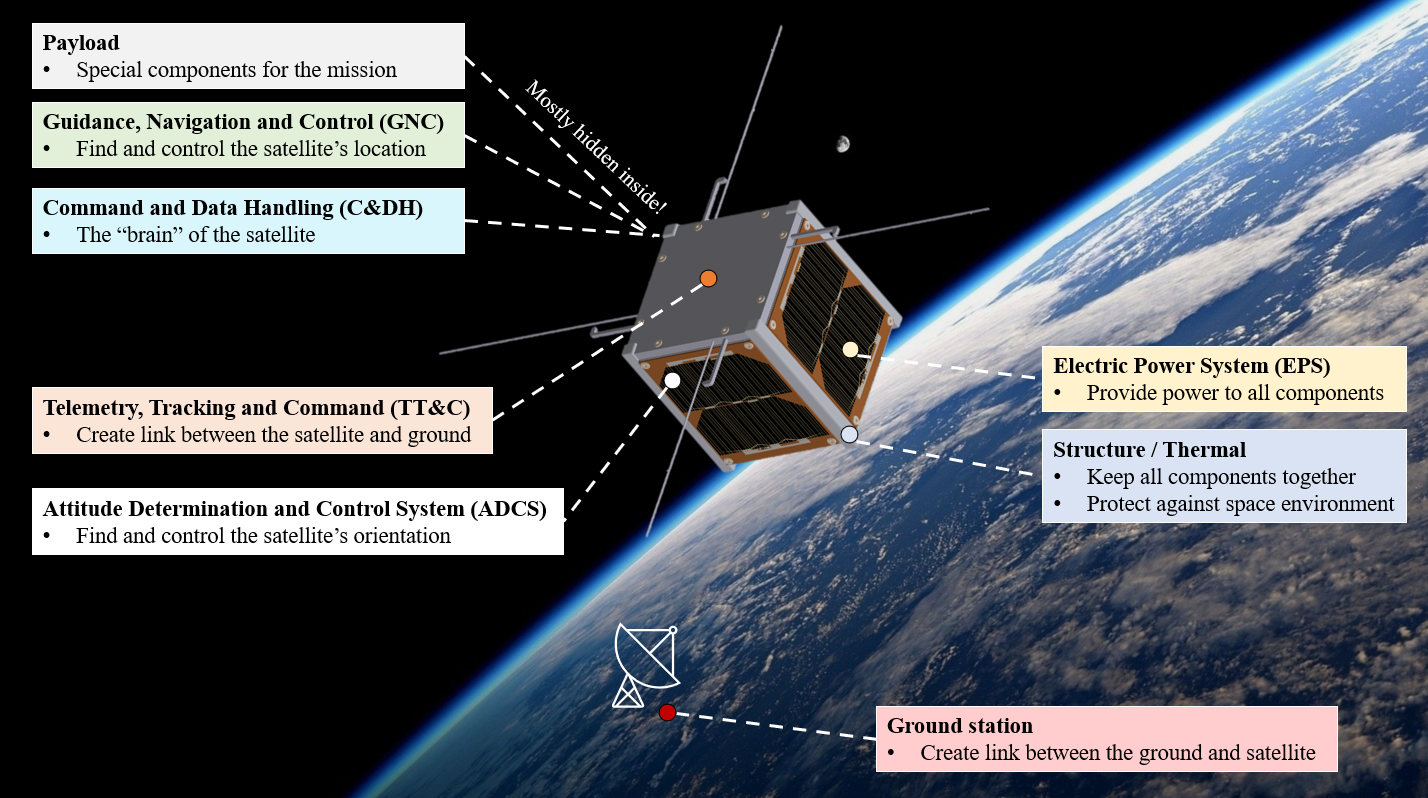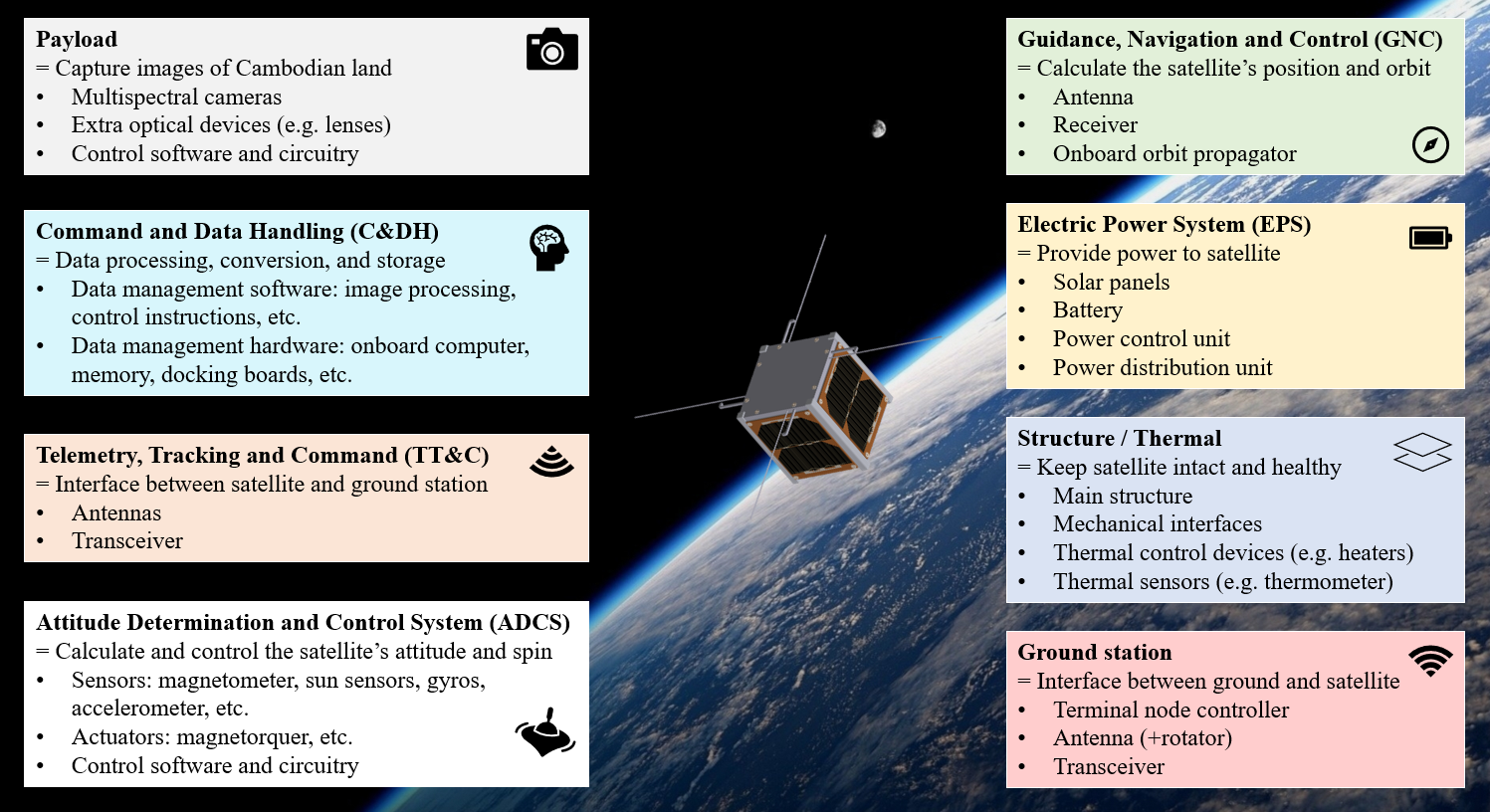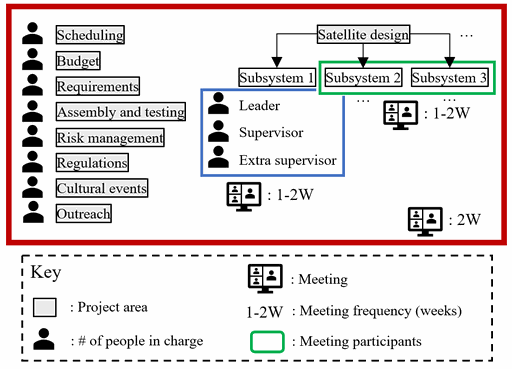
Apsara-1's subsystems
What is a satellite subsystem? What subsystems does Apsara-1 have?
What responsibilities are needed to design a subsystem?
Read on to find out more.
Satellite subsystems

Inside a small satellite: typical subsystems (plus ground station)
A "subsystem" is one part of a satellite. Each subsystem has a specific function, and contains several components to realise that function. Together, the different subsystems allow the satellite to survive in space, communicate with humans on Earth, and fulfil the mission objectives. Above, we show the eight main subsystems of a typical small satellite. (You may find different definitions in other sources.)
Look inside Apsara-1
Do you know what subsystems are inside Apsara-1? And do you know what each subsystem is made of?
Let us give you a sneak peak into our initial design.

Apsara-1's subsystems: components and functions (plus ground station)
Payload
The payload consists of several cameras to take pictures of Cambodian land. These are not ordinary cameras. The cameras are equipped with lenses and filters to capture images in different wavelength ranges: they are multispectral cameras. Control software and circuitry will also be developed to tell the cameras when to take pictures and send image data to the C&DH.
Command and Data Handling (C&DH)
The C&DH is responsible for commanding and managing the data between the payload and onboard data storage. It also converts communication between the satellite and the ground station, before it is sent or after it is received by the TT&C. The C&DH is the "brain" of the satellite: it provides an onboard computer, data storage, and data interfaces between subsystems.
Telemetry, Tracking and Command (TT&C)
The TT&C is the uplink and downlink communication interface between the C&DH and the ground station. It consists of a transceiver (to translate communication data) and a deployable antenna
.
Attitude Determination and Control System (ADCS)
The ADCS is used to calculate and control the orientation (also called attitude) of Apsara-1. This is important to take images, and to communicate with the ground. Attitude determination is based on sun sensors, a magnetometer, and a gyroscope. Attitude control uses magnetorquers (which create a magnetic field to interact with the Earth's own field). Control software and circuitry is being designed to operate the sensors and actuators.
Guidance, Navigation and Control (GNC)
GNC tells us where the satellite is, and where it is going. This information is important to take pictures at the right time, and to communicate with the satellite. The current satellite position and speed can be obtained using several methods. Two being considered for Apsara-1 are a GNSS antenna and receiver, and data uplinked from the ground station. To predict where the satellite will be in future, we are developing an onboard orbit propagator.
Electric Power System (EPS)
The EPS provides power for all active components inside the satellite. This includes power generation (solar cells), storage (batteries), and management (control and distribution units).
Structure / Thermal
The structure is the skeleton of the satellite. It must keep the satellite safe during launch from Earth, release into space, and operation until the end of the mission. This includes providing protection from vibration, temperature variation, and space radiation. The structure must mechanically support and connect all components, and yet keep them within a small size and volume for transportation to space. We may also use thermal devices to keep all components within suitable temperatures ranges.
Ground Station
The ground station is the interface between human operators on the ground and the satellite in space. We plan to develop a ground station in Phnom Penh consisting of a rotatable antenna to send and receive satellite data, a transceiver to translate communication data for uplink or downlink, and a controller.
Responsibilities for subsystem design
What do you need to know, to design, test, and make a satellite subsystem?
Let us explain some of the important skills and responsibilities, to develop the BBM (breadboard model) of Apsara-1.

All subsystems
Skills
Personal: teamwork, communication, sense of humour, negotiation, curiosity, time management.
Collaboration: PowerPoint, word processor, Slack, English.
Technical: physics, mathematics.
Payload
Responsibilities
Cameras: definition of requirements, purchasing, experimentation.
Circuit boards: design, manufacture.
Software for image processing: design, testing.
Skills: photography, programming, electronics.
Command and Data Handling (C&DH)
Responsibilities
C&DH hardware: definition of requirements, design, purchasing, testing.
Communication interfaces: design, testing.
Reset systems: design, testing.
Skills: data and computing, programming, electronics.
Telemetry, Tracking and Command (TT&C)
Responsibilities
TT&C hardware: definition of requirements, component selection.
Analysis: link budget.
Software: design of communication protocol.
Regulations: frequency management and registration.
Skills: data and communications, programming, negotiation, interest in regulations.
Attitude Determination and Control System (ADCS)
Responsibilities
Hardware: definition of requirements, component selection.
Software:
development and validation of ADCS simulator, design and testing of ADCS flight software.
Skills: simulation, control systems, programming (e.g. Matlab, Simulink).
Guidance, Navigation and Control (GNC)
Responsibilities
Hardware: definition of requirements,
component selection.
Software: development and validation orbital simulator.
Skills: simulation, orbital dynamics, programming.
Electric Power System (EPS)
Responsibilities
Hardware: definition of requirements, component selection.
Software: development and validation of EPS simulator, simulation and verification of EPS for Apsara-1 mission.
Skills: simulation, energy systems, programming.
Structure / Thermal
Responsibilities
Structure: definition of requirements, design (CAD), purchasing, manufacture (CNC machine at NPIC), verification.
Thermal: definition of requirements, component selection (if any), development and verification of thermal simulator.
Skills: mechanical design (including CAD), heat transfer, programming, simulation.
Ground Station
Responsibilities
(Note: ground station development will be conducted by the NPIC.)
Structure: definition of requirements, design, component purchasing, assembly, testing.
Control system: definition of requirements, control protocol design, component purchasing, assembly, testing.
Mission operations center: design and development.
